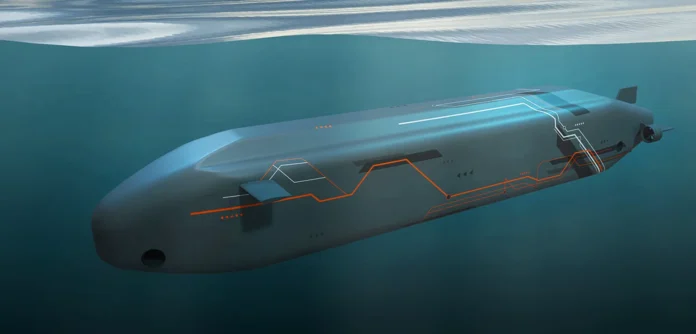
BAE Systems unveiled the third iteration of the Herne extra-large uncrewed underwater vehicle (XLUUV) at DSEI 2025. This will be available for the Royal Navy or export customers to purchase as an operational platform from the end of 2026, Navy Lookout reports.
Iterating fast
This latest version, ‘Herne Mk 3’, represents continued progress from the prototype shown in 2024, itself already a significant advance from the original concept presented at DSEI 2023. The second iteration was a substantially different vehicle and was demonstrated to media and overseas navies representatives at Portland last year. Though still compatible with 40ft containers, the latest version is slightly larger than its predecessor and has been reworked to improve endurance, stealth, and payload access.
The most visible change is a redesigned hull form with a longer and more integrated fairing for the retractable ISR mast. The welded steel frame has been replaced with a bolted aluminium framework, and the platform and its equipment now meet MIL-SPEC and defence standards. Side-mounted twin thrusters have replaced the twin propellers, and the X-form hydroplanes have been simplified to a crucifix arrangement. Some further hydrodynamic improvements to reduce the acoustic signature have been made, but without incorporating classified technology that would complicate matters by requiring ITAR certification.
Further practical enhancements include top-access bays that provide greater internal volume for power or payloads and ease of reconfiguration. These enable faster re-role options when switching between missions.
The partnership between BAE Systems and Cellula has progressed at speed. The original concept went from design to initial sea trials in just 11 months. Like many of the major defence primes, BAES has recognised the need to rapidly develop low-cost, uncrewed systems that can be mass-produced and iteratively developed, Herne being a good example of this.
Based on this momentum, the two companies have signed a 10-year exclusive agreement to continue developing Herne as a military-specific product line, with an initial market-ready variant expected to be available for delivery by the end of 2026.Multi role
Cellula Robotics has developed a hydrogen fuel cell module that provides over 5,000km of range and more than 45 days of submerged operation. There are also lithium-ion batteries, offering a flexible power solution, depending on the type of mission.
This persistent, air-independent propulsion unlocks a wide range of missions that demand slow, covert, and enduring presence underwater, conditions under which battery-powered platforms cannot operate effectively. BAES Nautomate control technology is core to the capability, a platform-agnostic system designed to provide common mission planning, autonomy, and decision support layers across a wide range of uncrewed platforms. Herne could operate alone, in swarms, or as part of a hybrid force including crewed submarines or surface ships. BAES is also working on communications methods for Herne, such as optical and acoustic systems or releasable buoys, to ensure data can quickly be transferred to the rest of the force.
The vessel is designed to perform various tasks, including seabed warfare, long-range ISR, and anti-submarine warfare. A thin line towed array sonar or other sonar arrays would probably be ideal initial payloads, something already trialled by the RN with the Manta XLUUV. Weapon release from XLUUVs may be some way off, but potentially, torpedoes could be launched vertically through the underside of Herne’s hull. This would allow covert attack or self-defence without the need for externally mounted tubes or surface exposure.
Aligning with RN ambition
In his punchy address at DSEI the First Sea Lord said the RN should be “uncrewed wherever possible” and needs to move to generate mass at scale without waiting for traditional, long-cycle warship [or submarine] builds. He promised the first sensors in the Atlantic Bastion concept would be in the water within a year.
With BAES presenting a mature solution that they have self-funded, there can be little reason why the RN should not build on the experience gained with its XV Excalibur XLUUV and purchase Herne, which will be available ‘off the shelf’ at the end of next year. Herne offers a platform which the RN could quickly and cost-effectively deploy as the initial ‘Type 93 Chariots’ – one of the first operational elements in the Atlantic Bastion concept.



